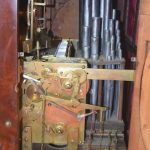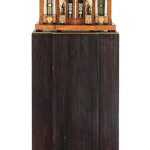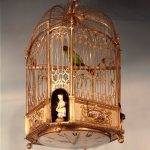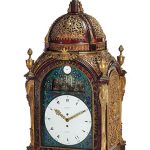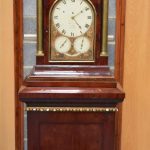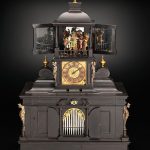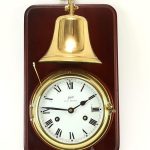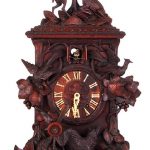Organ Pipes. An organ pipe is a sound-producing element of the pipe organ that resonates at a specific pitch when pressurized air (commonly referred to as wind) is driven through it. Each pipe is tuned to a specific note of the musical scale. A set of organ pipes of similar timbre comprising the complete scale is known as a rank; one or more ranks constitutes a stop. Reference: Wikipedia
Organ pipes inside of a clock
A unique first quarter of the 19th century Austrian ormolu, ebony and alabaster-mounted burr thuya wood automata organ clock J. Ad. Hoyer, Wien. The architectural case set with ormolu mounts and balustrades, the niches supported on alabaster columns, centred by a pair of a doors flanked by parcel gilt standing female caryatids, on a bow-fronted base, the 5.25 inch gilt dial centred by the white enamel Arabic dial with concentric date and moon hands, the gilt surround set with a pair of standing warriors, each with a raised arm moving in tandem with the gong-striking movement to sound the hours and quarters, the clock movement with circular plates cast with a wedge-shaped base, silk suspension striking the hours and the quarters on a pair of blued steel coiled gongs, activating the musical organ below playing a choice of seven melodies on twenty four wooden pipes. The 12 inch wooden pinned barrel powered by the large single gut fusee movement signed in full in copperplate script,’J. Ad. Hoyer, Wien’ wound from the right hand side door on the hour to strike the bell. An applied hand-written label on the barrel gives the following tune titles: 1. Ouverture aus Italiana in Algeri (Rossini 1813) 2. Polonaise di Rohsini 3. Schlussgesang aus der Elster (Rossini 1817) 4. Pas de deux aus Alfred (Gallenburg 1820) 5. Variationen/ Es ist alles eins 6. Ober und Unter Osterreicher 7. Marsch aus Alfred (Gallenberg 1820) height 53cm; width 55cm; depth 32cm
Sold for £ 28,812 inc. premium at Bonham’s in 2019
Gilt-metal clock in form of bird-cage; four enamel plaques and four painted porcelain figures; dial in base with second hand; verge movement; automaton movement operates organ and causes bird on perch to move. TRAIN-COUNTS. Organ part. Gt wheel 96 2ns wheel 72/36 3rd wheel 72/12 Worm wheel 30/12 Worm 3-start.
Date 1780-1785
Reference: © The Trustees of the British Museum
MONUMENTAL PENDULUM WITH MUSIC OF GEORGE III PERIOD SIGNATURE OF HENRY BORREL AND MARKWICK MARKHAM, LONDON, CIRCA 1780 In tortoiseshell veneer Caret and ornamentation of chased and gilded bronze, with openwork decoration of vases, flowers and horns abundance, the enameled dial signed MARKWICK / MARKHAM / BORREL / LONDON , the figures in Turkish characters on a background of glass paste with a floral pattern, the openwork needles, surmounted by an automaton decorated with metal, leather, cardboard and paper boats chewed on a background of twisted glass rods representing a cascade of flowing water surmounted by a small strike / silent dial , the mechanism signed Henri Borrel Londonon both sides, the recoil escapement with a transfer of articulation to allow a lateral pendulum, the rear discovering an organ with fifty and one pipes, ten tunes and seventeen keys, the body flanked by four vases and surmounted a dome decorated with three ostrich feathers topped with a dial indicating the ten tunes in a star, resting on eight feet decorated with foliage Height: 104 cm. (41 in.); Width: 50 cm. (191/2 in.); Depth: 41 cm. (16 in.) Width of the enameled plate: 30.5 cm (12 in.) Diameter of the enameled dial: 23.5 cm. (9 ¼ in.)
Sold for EUR 193,500 at Christie’s in 2015
A FINE REGENCY GIANT GILT BRASS MOUNTED MAHOGANY QUARTER STRIKING EIGHT DAY TURN-TABLE MUSICAL ORGAN CLOCK Thwaites & Reed, London C1820, The massive case with turntable base and resting on a later purpose-made mahogany, brass and gilt-wood mounted pedestal, the double inverted bell top with pineapple finials to all corners, gilt-brass trellis sound frets surmounted by large ball finial, drop handles above the side doors with three pull stops to the right side for the organ pipes, brass mouldings to the rear case angles and Ionic brass columns flanking the brass moulded front door, the 12 in. wide painted Roman dial with gilt-brass hands and signed Thwaites & Reed/Clerkenwell/LONDON, the lower half with polychrome floral decoration and tune music selection flanking the organ selector, the substantial triple chain and fusee movement with anchor escapement and striking the hours on a single bell and the quarters on a nest of eight bells, trip repeat, engraved border to the back plate signed Thwaites & Reed/Clerkenwell/LONDON, the substantial chain and fusee organ movement wound from the side and playing through 50 pipes via 30 cm. long pinned wooden barrel; pendulum? (235 cm.) high, over plinth.
Sold for £20,000 at Hannam’s Auctioneers Ltd in 2018
Musical Clock with Spinet and Organ ca. 1625 Veit Langenbucher German
Inside the ebony case of this musical clock is an extremely rare and important instrument consisting of a sixteen-note pipe organ and a sixteen-string spinet that may be played independently of the organ. Made by the renowned team of Samuel Bidermann and his son (also Samuel)–the father’s L-shaped pinning style appears in this work–and Viet Langenbucher, the extraordinary piece includes, in addition to the organ and spinet, a clock and five carved and colorfully clad commedia dell’arte figures that perform a circling dance in the clock’s tower when the instruments sound to mark the hours.
The complex clock is perhaps the most musically elaborate automatic instrument to survive from the early seventeenth century. Its three airs, probably by composer Hans Leo Hassler (baptized 1564-1612), the elder Bidermann’s teacher and once keeper of the knowledge of pinning barrels in Augsburg, are stored on the original pinned cylinder. Most cylinders and their tunes were replaced by subsequent generations, but this one was spared to provide us with an extremely rare musical document that allows us to hear the airs as they were played in the seventeenth century.
Reference: The Metropolitan Museum of Art
